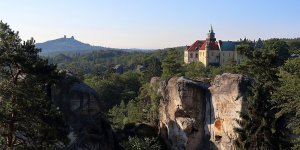| Published in Attractions / Places of Interest |
Town Hall (Stadhuis) in Brussels, Belgium
It is the only remaining medieval building of the Grand Place and is considered a masterpiece of civil Gothic architecture and more particularly of Brabantine Gothic.
The oldest part of the present Town Hall is its east wing (to the left when facing the front). This wing, together with a shorter belfry, was built and completed in 1420 under direction of Jacob van Thienen.
Initially, future expansion of the building was not foreseen, however, the admission of the craft guilds into the traditionally patrician city government apparently spurred interest in providing more room for the building.
As a result, a second, somewhat longer wing was built on to the existing structure, with Charles the Bold laying its first stone in 1444. This west wing was built by Guillaume (Willem) de Voghel who, in 1452, also built the Magna Aula at the Coudenberg.
The facade is decorated with numerous statues representing nobles, saints, and allegorical figures. The present sculptures are reproductions; the older ones are in the city museum in the King's House across the Grand Place.

Statues on the Brussels town hall. ![]()
The 96-metre-high (315 ft) tower in Brabantine Gothic style emerged from the plans of Jan van Ruysbroek, the court architect of Philip the Good. By 1454, this tower, replacing the older belfry, was complete. Above the roof of the Town Hall, the square tower body narrows to a lavishly pinnacled octagonal openwork. Atop the spire, stands a 5-metre-high gilt metal statue of the archangel Michael, patron saint of Brussels, slaying a dragon or devil.
The tower, its front archway and the main building's facade are conspicuously off-centre relative to one another. According to a legend, the architect, upon discovering this "error", leapt to his death from the tower. More likely, the asymmetry of the Town Hall was an accepted consequence of the scattered construction history and space constraints.

Wedding room in Brussels town hall. ![]()
The addition of two rear wings, in the classical style (Louis XIV style), transformed the L-shaped building into its present configuration: a quadrilateral with an inner courtyard, completed by Corneille Van Nerven in 1712. (Wikipedia)
YOU MAY ALSO LIKE






 If you own or manage a travel-related business such as a hotel, a bed-and-breakfast, a restaurant, a pub or a cafeteria, you can create a web page for your business for free on Titi Tudorancea Travel Info. » |
